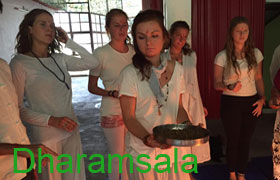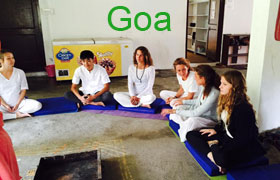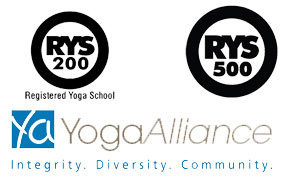Advanced Yoga Asanas 1
Kurmasana
Procedure
1. Keep both of your legs apart in the initial stage.
2. Now bend forward run your hands below your knees and clasp them behind your hips. Place your forehead on the floor.
3. Pause in this posture for a while and revert to the original state.
Benefits
1. It is helpful for indigestion, constipation and navel related issues.
2. It is useful for thighs and lower part of your legs.
Precautions
People who suffer with back ache and cervical problems should not practice this asana.
Padma Bakasana
Procedure
1. Sit in the posture of padmasana in the initial stage.
2. Then place both of your palms on the floor.
3. Now gradually raise the entire part of your body just balancing on your hands. Place both of your knees on the upper part of your elbows. Now the entire weight of your body will be residing on your palms. Pause in this posture for a while and revert to the original state that is to padmasana.
Benefits
1. This asana strengthens the muscles of your hands.
2. It is helpful in curing the stomach related diseases. It improves the concentration of your mind.
3. It can impart the benefits of padmasana too.
Precautions
1. If you suffer with pain in your knees or if your hands are too weak, you should not practice this asana.
2. People suffering with back ache also should not practice this asana.
Purna Matsyendrasana
Procedure
1. Sit in the posture of dandasana initially. Then fold your left leg and place it over your right thigh close to your navel.
2. Now bend your right leg and cross it over your left knee and place it in line with it.
3. Keep your left hand outwards near your right knee and try to hold your right feet or it toe.
4. Place your right hand behind your back and look behind.
Benefits
You can have all the benefits of ardha matsyendrasana. If you can stay in this posture for half an hour, your kundalini Shakti will be awakened.
Precautions
If you suffer with high blood pressure and experience pain in your thighs or knees, you should not practice this asana.
Ugrasana
Procedure
1. Sit down in the posture of dandasana.
2. Broaden your legs as far as you can.
3. Lean over and try to hold the toes of both of your legs with your hands.
4. Now bend forward to make your forehead touch the ground.
5. Pause in this posture for a while and then raise your forehead and release your toes and slowly revert to the original state.
Few peoples call this asana as bhunamanasana too.
Benefits
1. It makes your abdomen strong and eliminates the chances of attack of sciatica.
2. It alleviates constipation and indigestion.
Precautions
If you suffer with ulcer or back ache you should not practice this asana.
Kapotasana
Procedure
1. Sit in the posture of vajrasana.
2. Keep your knees apart and kneel down.
3. Now bend your body from back and make your forehead touch the floor and try to make your hands hold your ankles.
4. Pause in this posture for a while release your ankles and raise your complete body on the balancing on the strength of your hands. Now sit down in vajrasana. And then practice yoga mudra.
Benefits
It eliminates all the problems related to your spinal cord.
Precautions
You should never practice this asana in the case of hernia or high blood pressure.
Eka Pada Raja Kapotasana
Procedure
1. Sit down in the posture of dandasana.
2. Fold your right leg and place your ankle in front of your wormian bone.
3. Move your left leg backwards and try to bend it over and hold it with your hand. Now pull it with your hands and try to touch it with your head.
4. Pause in this posture for a while and relax. Then repeat this process with the other leg.
Benefits
1. It is capable of alleviating all the disease related to throat.
2. This asana is helpful in dealing with back ache.
3. It can very well influence your pelvic region.
4. It eliminates the excess fat from your stomach and thighs.
Precautions
1. You should avoid practicing this asana if you have undergone any surgery in your shoulders.
2. You should not practice this asana in case of high blood pressure too.
Ashtavakrasana
Procedure
1. Place your palms on the ground and sit with your knees bent.
2. Balance all your weight on your palms and bring your legs towards your leftand raise the up. Keep your left hand in between both of your legs and your right hand will be outside.
3. Pause for while in this posture and continue to practice on the other side too.
Benefits
1. This asana can provide you with excellent memory.
2. It improves concentration of your mind and imparts peace to it.
3. Your hand will be strengthened.
Precautionsy
If you have undergone any surgery in your wrist, you should not practice this asana.
Hanumanasana
Procedure
1. Sit down in the posture of dandasana.
2. Bring one of your legs backwards and stretch both of your legs to the extent possible.
3. Bring both of your hands into namaskara mudra in front of your chest.
4. This asana can be practiced on either sides.
Benefits
1. The name of the asana itself indicates that it can impart strength, wisdom, speed and energy.
2. It can alleviate egoism.
3. It eliminates the excess fat from the shank and thigh parts of your leg.
Adhomukh Vrikshyasana
This asana looks like an inverted tree. Hence it is called adhomukh vrikshyasana.
Procedure
1. Initially you can take the support of a wall. Place your palms on the floor and Inhale air. Raise both of your legs with all your strength.
2. The entire weight of your body is on your palms.
Benefits
1. It makes your hands stronger.
2. It can very well influence pituitary gland.
3. Blood circulation will be improved in reverse direction that is towards your head. Thus it brings a glow to your face.
Precautions
If you have any problem in your wrist, you should not practice this asana.
Vakasana
Procedure
1. Place your palms on the floor and sit with your knees bent.
2. Connect your knees on either sides.
3. Now lift your legs off from the floor and slightly lean over into the front.
4. The entire weight of your body rests on your palms.
Ekapada Vakasana
1. Get into the posture of vakasana and inhale air. Now straighten one of your legs. Pause in this posture for a while and repeat this process with the other leg too.
2. Then revert to the original state.
The benefits and precautions are the same for padmasana, vakasana ,and ekapada vakasana.
Supta Kurmasana
1. Sit in the posture of dandasana.
2. Place your legs one to two feet apart and bend forward.
3. Bring both of your hands from beneath your knees and hold the wrist of left hand with your right hand behind your back.
4. Now bring both of your legs over your neck.
5. Pause for a while in this posture and revert to the posture of dandasana.
Benefits and Precautions
Similar to those of kurmasana.
Vatayanasana
Procedure
1. Stand straight.
2. Fold your right leg and place it over your left thigh.
3. Raise both of your hands upwards while inhaling air.
4. Bend your body forward while exhaling air.
5. Make your right knee touch the ground near your left leg.
6. Bring your hands into namsakara mudra in front of your chest.
7. Pause for a while in this posture and repeat it on the other leg too.
Benefits
1. It can address all the issues related to gas.
2. It is useful to deal with all kinds of joint problems. It is effective on hernia.
3. It strengthens the shank and thigh muscles.
Precautions
If you have undergone any surgery in your knees or if you have any pain in your knees, you should not practice this asana.
Our yoga teacher training program in Goa is known for its perfect environment to learn these asanas.




